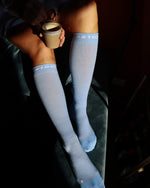Do you ever suffer from tired and heavy legs? You’re certainly not alone. In this blog, we explain what happens when you have tired legs, what the causes are, and most importantly, how you can prevent and treat this. Read on for useful tips and solutions or check out our collection of compression socks for immediate relief.

What happens when you have tired legs?
Tired legs often feel sluggish, heavy, and sometimes painful. This can have various causes. It is often a result of reduced blood circulation, which means the leg muscles do not receive enough oxygen-rich blood. This can lead to a feeling of heaviness and fatigue. Sometimes fluid retention plays a role, but other factors such as prolonged standing or sitting, overexertion, or muscle fatigue can also contribute to the sensation of tired legs.
Symptoms of tired legs
Tired legs can cause various discomforts, such as:
1: A heavy, sluggish feeling
3: Swollen ankles and feet
4: Tingling or a restless sensation, similar to restless legs
Causes of tired legs
Activity
Intensive physical effort, such as sports or a long walk, can lead to muscle overexertion. People with standing professions, such as hairdressers or hospitality staff, often experience increased pressure on their legs, which can result in fatigue and a higher risk of varicose veins. Check out our recovery socks to promote muscle recovery.
Inactivity
Prolonged sitting, for instance during a workday or a long journey, worsens blood circulation. This can lead to fluid buildup in the ankles and heavy, tired legs.
Other factors
Age plays a role, as blood vessel walls become less elastic as you get older. Incorrect foot posture can also contribute to tired legs because your leg muscles have to constantly correct themselves. Additionally, pregnancy or being overweight can put extra pressure on your legs, contributing to fatigue and discomfort.
What can you do about tired legs?
Fortunately, there are various solutions you can apply yourself to relieve tired legs:
Move Regularly
Physical activity stimulates circulation and prevents stiffness. Take frequent breaks to walk or stretch, especially if you sit or stand for long periods.
Massage Your Legs
Massaging your legs helps improve blood circulation and relaxes the muscles.
Elevate Your Legs
Raising your legs can help reduce fluid retention and improve circulation. This is particularly helpful for those experiencing painful legs.
Wear Comfortable Clothing
Tight clothing, such as skinny jeans or restrictive socks, can limit circulation. Opt for loose, breathable clothing.
Wear Compression Socks
One of the most effective ways to prevent and treat tired legs is by wearing compression socks. These improve circulation, reduce swelling, and relieve heaviness. They’re particularly beneficial for those who stand, sit for long periods, or engage in sports.
The Role of Compression Socks in Tired Legs
Compression socks are a powerful solution for tired legs. They apply pressure to the legs, improving circulation and reducing fatigue.
Improve Circulation with Compression Socks
The controlled pressure exerted by compression socks helps direct blood flow back to the heart, preventing fluid buildup and reducing the feeling of heavy legs.
Extra Support for Your Muscles
Compression socks provide muscle support, reducing fatigue and promoting faster recovery after physical activity.











